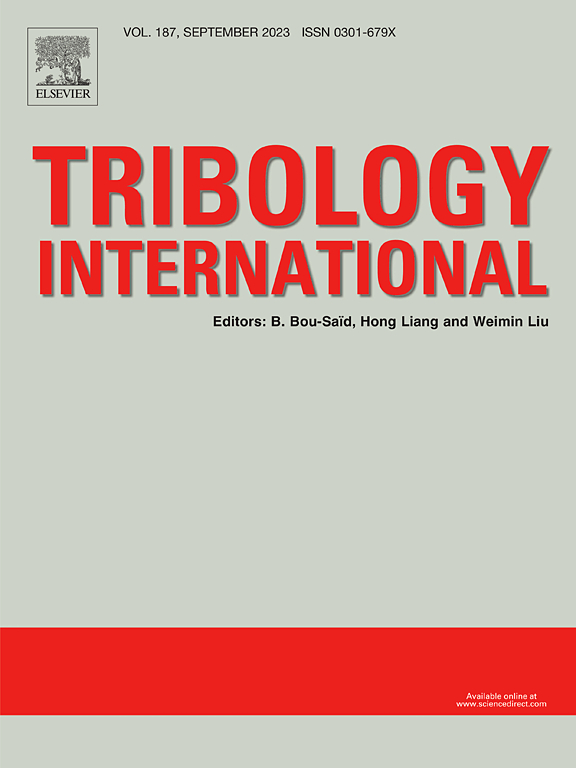Temperature-driven evolution of oxide films on MAX300 steel and corresponding wear behavior under high-speed friction
IF 6.1
1区 工程技术
Q1 ENGINEERING, MECHANICAL
引用次数: 0
Abstract
The temperature-driven evolution of oxide films on MAX300 steel was comprehensively investigated through a series of high-speed friction tests (up to 104 m/s), along with scanning electron microscopy, X-ray diffraction, electron backscatter diffraction analysis, and molecular dynamics (MD) simulations. At a load of 300 N, increasing the sliding speed led to the formation of thicker but brittle gradient oxide films with low binding energy, resulting in spallation and peak wear at 6000 rad/min. At 9000 rad/min, a dense, self-lubricating film formed, significantly reducing wear. At a higher load of 600 N, the oxide film initially thickened owing to dislocation accumulation and then densified through high-temperature sintering. MD simulations showed enhanced interfacial binding, confirming improved film stability.
高速摩擦下MAX300钢氧化膜的温度驱动演化及磨损行为
通过一系列高速摩擦试验(高达104 m/s),以及扫描电子显微镜、x射线衍射、电子背散射衍射分析和分子动力学(MD)模拟,全面研究了MAX300钢氧化膜的温度驱动演变。在300 N的载荷下,增加滑动速度导致形成较厚但脆性较低结合能的梯度氧化膜,导致剥落并在6000 rad/min时出现峰值磨损。在9000 rad/min时,形成致密的自润滑膜,显著减少磨损。在较高的600 N载荷下,氧化膜先是因位错积累而增厚,然后通过高温烧结而致密化。MD模拟显示界面结合增强,证实了膜稳定性的提高。
本文章由计算机程序翻译,如有差异,请以英文原文为准。
求助全文
约1分钟内获得全文
求助全文
来源期刊

Tribology International
工程技术-工程:机械
CiteScore
10.10
自引率
16.10%
发文量
627
审稿时长
35 days
期刊介绍:
Tribology is the science of rubbing surfaces and contributes to every facet of our everyday life, from live cell friction to engine lubrication and seismology. As such tribology is truly multidisciplinary and this extraordinary breadth of scientific interest is reflected in the scope of Tribology International.
Tribology International seeks to publish original research papers of the highest scientific quality to provide an archival resource for scientists from all backgrounds. Written contributions are invited reporting experimental and modelling studies both in established areas of tribology and emerging fields. Scientific topics include the physics or chemistry of tribo-surfaces, bio-tribology, surface engineering and materials, contact mechanics, nano-tribology, lubricants and hydrodynamic lubrication.
 求助内容:
求助内容: 应助结果提醒方式:
应助结果提醒方式:


